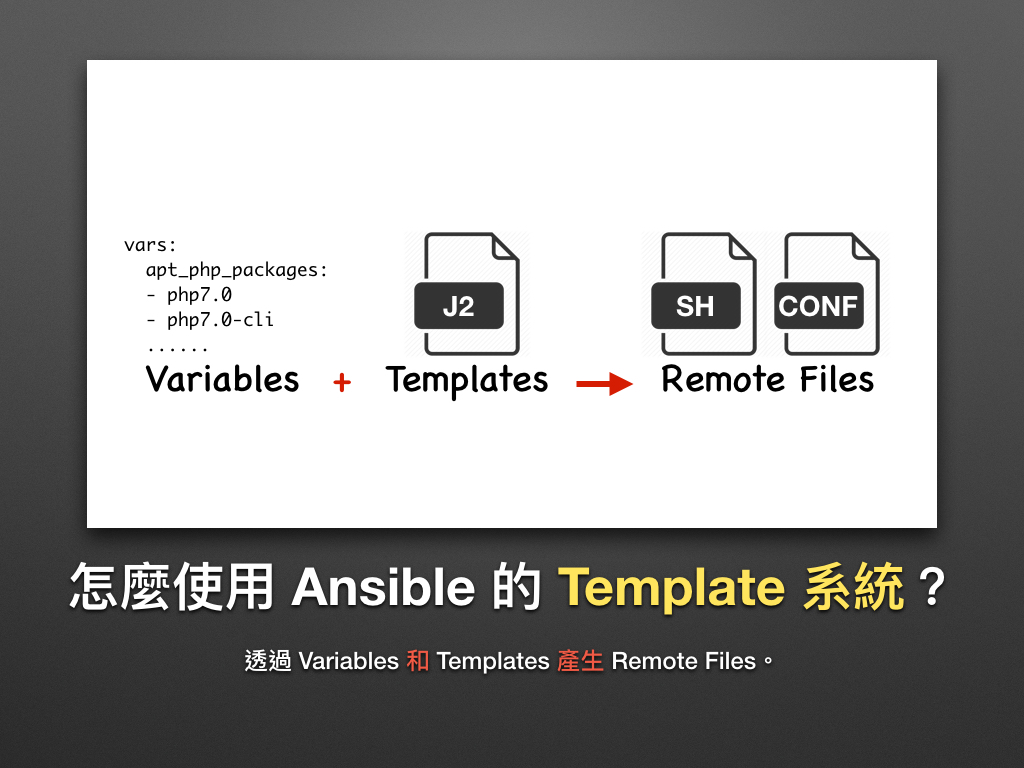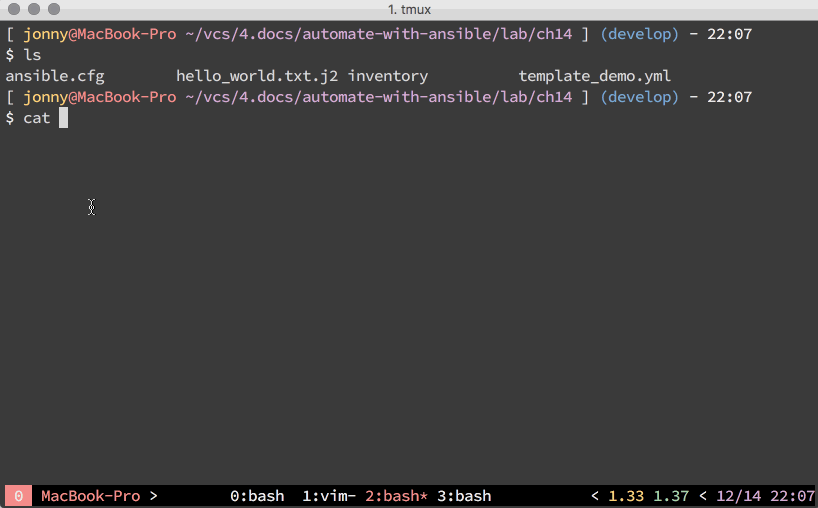現代 IT 人一定要知道的 Ansible 自動化組態技巧
14. 怎麼使用 Ansible 的 Template 系統?
template module 是凍仁常用的檔案模組 (Files Modules) 之一,先前在「12. 常用的 Ansible Module 有哪些?」一章時,也曾提到可以用它和變數 (Variables) 來操作檔案。
 ▲ 圖片來源:http://www.freeiconspng.com/free-images/txt-file-icon-1203
▲ 圖片來源:http://www.freeiconspng.com/free-images/txt-file-icon-1203
我們只需事先定義變數和模板 (Templates),即可用它動態產生遠端的 Shell Scripts、設定檔 (Configure) 等。換句話說,我們可以用一份 template 來產生開發 (Development)、測試 (Test) 和正式環境 (Production) 等不同環境設定。
舉例說明
說了那麼多,還是讓凍仁舉個例子說明吧!
建立 template 檔案。
$ vi hello_world.txt.j2 Hello "{{ dynamic_word }}" ↑ ↑ ↑- 由於 Ansible 是藉由 Jinja2 來實作 template 系統,所以請使用
*.j2的副檔名。 - 上面的
"{{ dynamic_word }}"代表我們在此 template 裡使用了名為dynamic_word的變數。
註:
raw和endraw是為了相容 GitBook 所增加的語法,您可能會在某平台上看到它,請忽略之。- 由於 Ansible 是藉由 Jinja2 來實作 template 系統,所以請使用
建立 playbook,並加入變數。
$ vi template_demo.yml 1 --- 2 - name: Play the template module 3 hosts: localhost 4 vars: 5 dynamic_word: "World" 6 7 tasks: 8 - name: generation the hello_world.txt file 9 template: 10 src: hello_world.txt.j2 11 dest: /tmp/hello_world.txt 12 13 - name: show file context 14 command: cat /tmp/hello_world.txt 15 register: result 16 17 - name: print stdout 18 debug: 19 msg: "{{ result.stdout_lines }}" 20 21 # vim:ft=ansible :- 在第 5 行,我們幫
dynamic_word變數設了一個預設值World。 - 在第 8 行的第 1 個 task 裡,我們使用了 template module,並指定了檔案的來源 (src) 和目的地 (dest)。
- 之後的 2 個 tasks 則是把 template module 產生出來的檔案給印出來。
註:
raw和endraw是為了相容 GitBook 所增加的語法,您可能會在某平台上看到它,請忽略之。- 在第 5 行,我們幫
執行 playbook。

直接執行 playbook。
$ ansible-playbook template_demo.yml透過
-e參數將dynamic_word覆寫成 ansible。$ ansible-playbook template_demo.yml -e "dynamic_word=ansible"透過
-e參數將dynamic_word覆寫成 Day14。$ ansible-playbook template_demo.yml -e "dynamic_word=Day14"
怎麼讓 Playbooks 切換不同的環境?
在 Playbooks 裡除了用
vars來宣告變數以外,還可以用vars_files來 include 其它的變數檔案,如下例的第 7 行。$ vi template_demo2.yml 1 --- 2 - name: Play the template module 3 hosts: localhost 4 vars: 5 env: "development" 6 7 vars_files: 8 - vars/{{ env }}.yml 9 10 tasks: 11 - name: generation the hello_world.txt file 12 template: 13 src: hello_world.txt.j2 14 dest: /tmp/hello_world.txt 15 16 - name: show file context 17 command: cat /tmp/hello_world.txt 18 register: result 19 20 - name: print stdout 21 debug: 22 msg: "{{ result.stdout_lines }}" 23 24 # vim:ft=ansible :註:
raw和endraw是為了相容 GitBook 所增加的語法,您可能會在某平台上看到它,請忽略之。建立
vars/development.yml,vars/test.yml和vars/production.yml檔案,接下來將依不同的環境 include 不同的變數檔案 (vars files),這樣就可以用同一份 playbook 切換環境了!Development
$ vi vars/development.yml dynamic_word: "development"Test
$ vi vars/test.yml dynamic_word: "test"Production
$ vi vars/production.yml dynamic_word: "production"
執行 playbook,並透過
-e切換各個環境。
此例是個簡單的範例,若要在大型的 Playbook 裡切環境,建議使用較進階的
group_vars和host_vars,詳情請參考「19. 如何維護大型的 Playbooks?」一章。
後語
template 系統是實務上很常見的手法之一,藉由它我們可以很輕鬆的讓開發、測試和正式環境無縫接軌。
現在是不是有寫 code 管機器的感覺了呢?(笑)